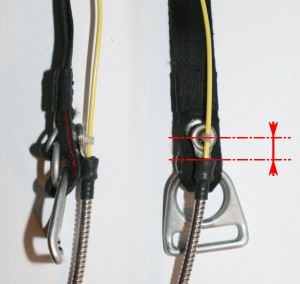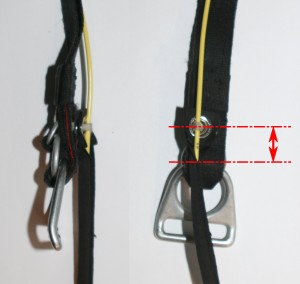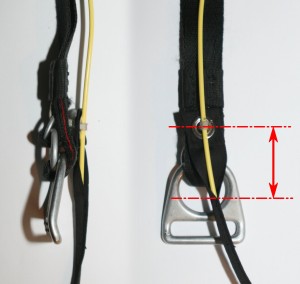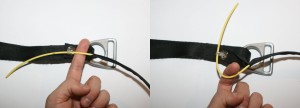With a properly manufactured, maintained, and correctly assembeld 3 ring there is practically no chance of an unintentional cutaway. The obvious reasons for such an unintentional cutaway would be a getting the release handle snagged on something, a broken loop due to wear, etc. However, one thing that is getting overseen a lot is the riser end of the sofhousings.
To see what I mean lets have a look at a hardhousing first. The distance between the end of the housing and the grommet is rather small, so when the 3 ring release is assembled there is only a little portion of yellow cable exposed below the loop. Cutting away the riser by pulling the yellow cable out at this point without additional tools requires quite some fiddling around and is pretty much impossible when the riser is loaded and there is some tension on the loop.
 Now lets look at a softhousing. The exposed portion of yellowcable below the loop is noticeably longer that with a hardhousing. To keep this to a minimum the softhousing is stitched up as far as possible towards the grommet.
Now lets look at a softhousing. The exposed portion of yellowcable below the loop is noticeably longer that with a hardhousing. To keep this to a minimum the softhousing is stitched up as far as possible towards the grommet. I’ve already seen quite a few rigs where the softhousing tunnel hasn’t been stitched up that far, sometimes exposing quite a lot of yellow cable. This opens quite a big gap in between grommet and housing where something rather big like a finger or gopro screw can snag the yellow cable and release the riser even when under load.
I’ve already seen quite a few rigs where the softhousing tunnel hasn’t been stitched up that far, sometimes exposing quite a lot of yellow cable. This opens quite a big gap in between grommet and housing where something rather big like a finger or gopro screw can snag the yellow cable and release the riser even when under load.
 So what’s ok and what’s not?
So what’s ok and what’s not?
I honestly don’t know if there is a recommended practice for manufacturing softhousings for 3-ring releases. The 3-ring construction manual from UPT does not state anything about housings.
I found that on most softhousings this distance between center of grommet and the last stitch of the webbing tunnel is 1″ (2,5cm like on the first picture) or less, which is about as close as you can go with a regular sewing machine presser foot after the grommet was set. This is tight enough to make it very hard to pull the yellow cable out at this point, and again pretty much impossible when riser is loaded.
A good rule of thumb is, the more pain in the ass it is to release the riser (on the ground) by pulling the yellow cable out at this point, the better. So if you can easily release a riser with a finger, you should stitch the softhousing tunnel up closer towards the grommet.